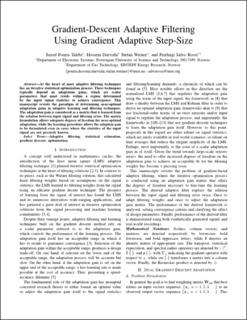| dc.contributor.author | Talebi, Sayedpouria | |
| dc.contributor.author | Darvishi, Hossein | |
| dc.contributor.author | Werner, Stefan | |
| dc.contributor.author | Salvo Rossi, Pierluigi | |
| dc.date.accessioned | 2023-01-27T07:11:10Z | |
| dc.date.available | 2023-01-27T07:11:10Z | |
| dc.date.created | 2022-05-10T14:53:27Z | |
| dc.date.issued | 2022 | |
| dc.identifier.issn | 1551-2282 | |
| dc.identifier.uri | https://hdl.handle.net/11250/3046725 | |
| dc.description.abstract | At the heart of most adaptive filtering techniques lies an iterative statistical optimisation process. These techniques typically depend on adaptation gains, which are scalar parameters that must reside within a region determined by the input signal statistics to achieve convergence. This manuscript revisits the paradigm of determining near-optimal adaptation gains in adaptive learning and filtering techniques. The adaptation gain is considered as a matrix that is learned from the relation between input signal and filtering error. The matrix formulation allows adequate degrees of freedom for near-optimal adaptation, while the learning procedure allows the adaption gain to be formulated even in cases where the statistics of the input signal are not precisely known. | en_US |
| dc.language.iso | eng | en_US |
| dc.publisher | IEEE | en_US |
| dc.title | Gradient-Descent Adaptive Filtering Using Gradient Adaptive Step-Size | en_US |
| dc.title.alternative | Gradient-Descent Adaptive Filtering Using Gradient Adaptive Step-Size | en_US |
| dc.type | Journal article | en_US |
| dc.type | Peer reviewed | en_US |
| dc.description.version | acceptedVersion | en_US |
| dc.rights.holder | © 2022 IEEE. Personal use of this material is permitted. Permission from IEEE must be obtained for all other uses, in any current or future media, including reprinting/republishing this material for advertising or promotional purposes, creating new collective works, for resale or redistribution to servers or lists, or reuse of any copyrighted component of this work in other works. | en_US |
| dc.source.journal | Proceedings of the IEEE Sensor Array and Multichannel Signal Processing Workshop | en_US |
| dc.identifier.doi | 10.1109/SAM53842.2022.9827710 | |
| dc.identifier.cristin | 2023181 | |
| dc.relation.project | Norges forskningsråd: 300102 | en_US |
| cristin.ispublished | false | |
| cristin.fulltext | postprint | |
| cristin.qualitycode | 1 | |
